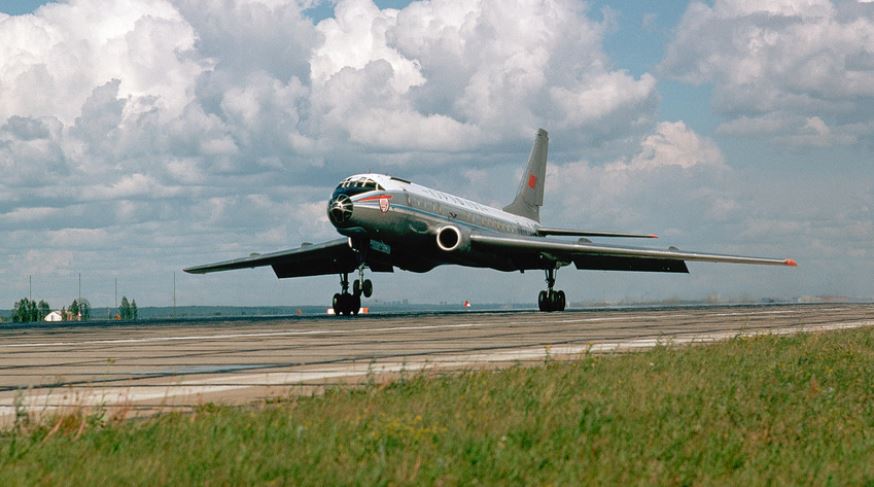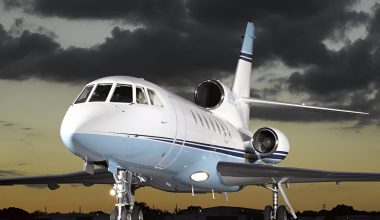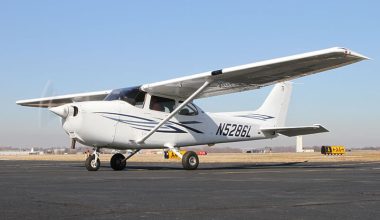Passenger air transport in modern times is dominated by jet-powered airliners. Jet airplanes represent a giant leap in aircraft design that made air travel more reliable, safer, and less costly than ever. Looking at aviation history, the age of the jet airliner began with the entry of de Havilland DH.106 Comet in 1952. As the British-built Comet was beginning to prove itself in passenger service, the USSR needed to develop a similar airliner. Tupolev Tu-104 was the Soviet’s first jet airliner that made its maiden flight on June 17, 1955, and entered civil service a year later. Soviet aviation took an adventurous step forward, with Tu-104 becoming the world’s third jetliner to take off.

Tupolev Tu-104 is a retired twin-engined, narrow-body jet airliner derived from the earlier Tu-16 heavy bomber. The manufacturer of Tu-104 is Tupolev, a century-old Russian aerospace and defense company founded by Andrei Tupolev. When the first serial Tu-104 took off in 1955, it became the third jet airliner in the world to hit the skies. But, its introduction with Aeroflot in 1956 made it the second jetliner to enter regular service.
Moreover, the legendary Tu-104 was the world’s only active jetliner between 1956 and 1958. The British-made Comet was laid off rock bottom due to the discovery of structural problems during that period.
The Russian aerospace giant Tupolev built 201 Tu-104s during a four-year production run from 1956 to 1960. Starting life as a commercial airliner, Tu-140 evolved with different iterations like freighter/medevac, testbed aircraft, etc. The foremost Soviet passenger jet, Tupolev Tu-104, shuttled over 90 million passengers over its lifetime with Aeroflot. The era in Soviet commercial aviation ended when Tu-104 made its last flight in November 1986.
What was the reason behind the development of the Tu-104 aircraft? What was its design like? How long did it remain in service? Let’s dive right into the development and operational history of the revolutionary Soviet-made Tu-104.
Development of Tu-104
In the late 1940s and early 1950s, modern civil airliners were a genuine requirement for the Soviets. Their existing airliners were distinctly lagging behind the Western technologically-advanced aircraft. Flying across the vast expanse of USSR territory would take days as airplanes required multiple refueling stops. The fuel range was inefficient, and the flight operation was vulnerable to inclement weather conditions.
The Soviet flag carrier Aeroflot needed a new passenger airliner that could outclass piston-engined planes in capacity and performance. Soviet aircraft manufacturer Tupolev proposed an aircraft design based on its Tu-16 bomber-missile carrier. The twin-engined jet strategic bomber Tu-16 was a commercial success with outstanding flight characteristics.

Since the Brits had already leaped into the jet age with de Havilland Comet, the USSR contended to develop a similar jet airliner. But then, the creation of a new airliner would require significant time and resource commitment. In such a case, producing the civilian adaptation of the Tu-16 bomber would be the perfect solution. This would save significant engineering time and money for the Soviets while maintaining the country’s lead in the race for primacy.
The British-built Comet pushed aviation engineering to the forefront, putting the UK at the cutting edge of aviation technology. The skyward Soviet Union had to introduce a modern jet aircraft that would propel the country’s civil aviation well into the future. So, Tupolev developed the Tu-104 project, which would be the civilian airliner version of the jet-powered Tu-16 heavy bomber.
Design of Tupolev Tu-104
The new civil Tu-104 aircraft shared the forerunner Tu-16’s wings, engines, and tail surface design features. However, it incorporated a wider, pressurized fuselage with a seating capacity for 50 passengers. The wider fuselage required longer runways for landing, which many airports of that time didn’t have. So, a drag parachute was attached to the aircraft to knock off the landing distance by up to 400m.
Also Read: Fall of TU-144, Tupolev TU144, the Soviet supersonic aircraft
The awe-inspiring Tu-104 aircraft was fitted with 2 Mikulin AM-3M-500 turbojet engines to fly at a maximum speed of 950km/hr. Beyond 50 passengers, it could accommodate two pilots, a navigator, and a flight engineer at the front. Tupolev Tu-104 was deemed challenging to operate as it had heavy flight controls and was fast on the final approach. Nonetheless, the pilots with experience operating the Tu-16 quickly transitioned into and mastered the art of flying the Tu-104.
Entry into service
The USSR’s pioneering jet airliner, Tupolev Tu-104, entered regular service with Aeroflot on September 15, 1956. The aircraft performed its first regular flight on the domestic Moscow-Omsk-Irkutsk route. The jet-powered Tu-104 proved useful for the Soviet national carrier by curtailing the flight duration to 7 hours and 40 minutes. The replaced propeller-powered Ilyushin Il-14 would take 13 hours and 50 minutes to operate the flight on the same route.

On top of impressive speed, the Tu-104 also delivered increased passenger comfort with a wider and pressurized cabin. Soon, Tu-104 became the workhorse of Aeroflot and formed the core of the flag carrier’s fleet. By 1957, the new jet was already playing a role in Aeroflot’s international passenger-carrying operations. From Vnukovo Airport in Moscow, the Tu-104 ferried passengers to London, Copenhagen, Brussels, and Prague in Europe, Delhi and Beijing in Asia, etc.
Popular with Aeroflot, the Tu-104 also found favor outside the country from CSA Czechoslovak Airlines. The Czech Republic flag carrier became the Tu-104 customer in 1957 and deployed the aircraft on routes to Moscow, Paris, and Brussels. It purchased four brand-new and two used Tu-104 units that could carry 81 passengers each. CSA operated the Prague-Moscow route exclusively with the TU-104A variant, becoming the world’s first carrier to serve a route solely with jetliners.
Popularity of Tupolev Tu-104
The then-largest carrier in the world, Aeroflot, widely used Tupolev Tu-104 throughout the 1960s and 1970s. The jet-powered airliner mostly served international routes since domestic airports didn’t have long runways required for Tu-104 acceleration.

In 1960, around one-third of air passengers that traveled across the vast expanse of the USSR flew onboard Tu-104. Over its 23 year-operation-period, the Tu-104 fleet clocked in 2 million flight hours, performing six hundred thousand + flights. Over the type’s service life, close to 100 million passengers flew on the Tu-104 fleet.
While the first Tu-104 had 50 passenger seats, it was stretched over time, with subsequent variants seating up to 100 passengers. When Tupolev ceased the Tu-104 production in 1960, some 200 units were produced to serve multiple roles. Some of the variants of the Tu-104 include:
- Tu-104A: The 70-seater aircraft that became the definitive production variant. Engines were improved, and the passenger capacity increased. A total of 80 TU-104As were manufactured.
- Tu-104B: The 100-seater passenger aircraft with stretched fuselage and new Mikulin AM-3M-500 turbojets. The first Tu-104B was introduced between Moscow and Saint Petersburg on April 15, 1959. Tupolev manufactured 95 Tu-104B airframes.
- Tu-104E: Fitted with RD-16-15 engines, the new Tu-104E offered better fuel efficiency and higher performance.
- TU-104G: A VIP-configured Tu-104 aircraft designed to carry high-profile federal government authority.
- Tu-104D: Another VIP model of Tu-104 featuring two sleeper cabins forwards and a cabin aft seating 39 passengers.
The downfall of Tupolev Tu-104
The career of Tupolev Tu-104 wasn’t without controversy. Although the aircraft was way ahead of its time, it had a poor safety record compared to its Western counterparts. The type was involved in numerous accidents and incidents, leading to 1140 fatalities between 1958 and 1981.
Tu-104 weighed heavy and had low-speed flying. Its flying controls weren’t much responsive, and the poor wing design made the plane prone to stalling with little-to-no warning. The propensity to stall and pitch up violently before the stall forced the aircrew to land at speeds above the recommended approach speed.
The fatal Tu-104 accident at Moscow prompted the national airline Aeroflot to retire the type in March 1979. Although the Tu-104 saw the end of civilian service, it still found a role in the Soviet military as a staff transport. The last straw that ultimately led to the permanent removal of the Tu-104 from the service was the 1981 military crash.
In February 1981, a Tupolev Tu-104A bound for via Khabarovsk crashed and burned into flames during takeoff from Pushkin. The aircraft carried 44 passengers and six crew members when it stalled during its takeoff run at Pushkin Airport. The aircraft entered the right bank, hit the ground 20m southwest of the runway, and crashed. All 50 occupants, including 28 high-ranking Soviet armed personnel, lost their lives in the accident.
Legacy of Tupolev Tu-104
Although Tupolev Tu-104’s road to the jet age was paved with hits and misses, it stalled further advancements in passenger aviation. The aircraft laid the foundation for the dynasty of Tupolev aircraft that remains today. Tupolev Tu-104 wasn’t a perfect aircraft, but its costly mistakes catalyzed increased safety in newer-generation airliners. Tupolev Tu-104 is the pride of the USSR and a groundbreaking innovation in Soviet aerospace engineering.






